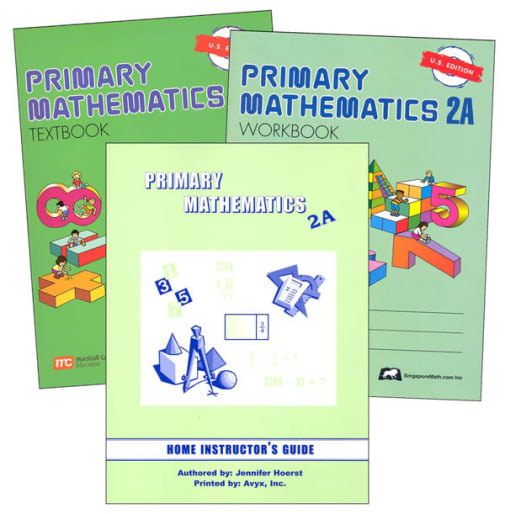This set includes the Textbook, Workbook, and Home Instructor's Guide for the first semester of grade 2. For more information on any item click on the link for a full product description.
Primary Math US 2A Set
Description
Package includes the following items:
Primary Math U.S. Edition uses the Singapore methodology (based on the Singapore’s Ministry of Education Syllabus) that employs a concrete-to-pictorial-to-abstract approach to teaching. Concrete illustrations are incorporated heavily in the early grades, gradually giving way to more abstract representations so that math is learned meaningfully. The program builds strong problem solving, critical thinking, and computational skills through well-chosen practice problems. Primary Math focuses on topics such as using whole numbers, fractions, and decimals, perimeter, area, volume, angles, quadrilaterals, symmetry, time, length, weight, money, graphs, and algebraic expressions. American money and U.S. measurements are included in the U.S. edition of this curriculum.
Each grade consists of two semester sets to be completed in one year. The ‘A’ textbook and workbook would be first semester, and the ‘B’ textbook and workbook would be second semester. Although the pace of the course really depends on the individual student, 2-3 pages in the text is usually enough for one day's lesson. Brief teacher instructions are provided in the textbook’s preface, but the Home Instructor Guide offers answers and more in-depth instruction and how to use optional manipulatives for the parent. Sets include text, workbook, and Home Instructor’s Guide.
We also offer supplemental Primary Math U.S. Extra Practice Books for each grade level. Optional, these helpful Extra Practice books provide additional practice problems organized by grade level topics. Convenient math manipulative kits are also available. Compared to Saxon Math, Primary Math encompasses a narrower scope. While Saxon Math covers coordinate graphing, negative numbers, square roots, and probability, these topics are omitted from Primary Math and are not covered until New Elementary Math. The smaller scope, however, allows the program to emphasize the basics. Primary Math focuses on the four arithmetic operations (using whole numbers, fractions, and decimals), perimeter, area, volume, angles, quadrilaterals, symmetry, time, length, weight, money, graphs, and algebraic expressions (introduced in 6th grade). Saxon Math moves a bit slower introducing Algebra in Math 87.
| Product Format: | Product Bundle |
|---|---|
| Grade: | 2 |
| Brand: | Rainbow Resource Center |

